Response of drainage to tectonics and PS-InSAR derived deformation study in Bilaspur, northwestern Himalaya, India
2022-05-18MoulishreeJoshiGirishChKothyariKapilMalikAjayKumarTaloor
Moulishree Joshi , Girish Ch Kothyari , Kapil Malik , Ajay Kumar Taloor
a Department of Geology Kumaun University, Nainital, India
b Institute of Seismological Research, Gandhinagar, Gujarat, India
c IIT Indian School of Mines, Dhanbad, India
d Department of Remote Sensing and GIS, University of Jammu, Jammu, India
ABSTRACT The study of drainage patterns in tectonically active regions is conducive to the prediction of regional geomorphology.Subtle subsurface changes can be detected by drainage conditions and manifested in the form of drainage anomalies. The Satluj valley of Bilaspur, which is traversed by numerous faults in northwest Himalayan region,was selected to analyze the effect of active tectonics on drainage evolution.With the Persistent Scatterer Interferometric Synthetic Aperture Radar(PS-InSAR)technique,SENTINEL-1A data were used to estimate the active surface deformation between September 2015 and December 2020. The results show that the region between Barasar Thrust (BrT) and Main Central Thrust (MCT) is undergoing deformation of ±12 mm/yr. The Stream Power Incision Model (SPIM) was used to predict deformation patterns. To validate the tectonic activity generated by the drainage network, seismic bvalues were calculated, indicating the accumulating stresses. This study shows the importance of drainage anomalies in tectonically active areas. When used in close combination with other seismotectonic parameters, drainage anomalies can be effective in delineating tectonically active regions.© 2022 Editorial office of Geodesy and Geodynamics. Publishing services by Elsevier B.V. on behalf of KeAi Communications Co. Ltd. This is an open access article under the CC BY-NC-ND license (http://creativecommons.org/licenses/by-nc-nd/4.0/).
Keywords:Geomorphology Deformation Satluj river Himachal Himalaya
1. Introduction
Regional drainage is significantly influenced by tectonic deformation, which causes changes in channel slope and leads to changes in its morphology. Drainage systems make an essential contribution to changes in the regional landscape [1-3]. Studying the nature and intensity of drainage helps to explain regional geomorphology.The response of rivers and other drainage systems to active tectonics has been well documented by many researchers[4-11].The geodetic studies and experimental models suggest that the river channel morphology and slope of the basin can be modified by continuous minor deformation(2-3 mm/yr)[3,12].Indepth analysis of the drainage patterns can provide immense information on fault evolution [2,13-15]. An upthrust fault block across the river may form a lake or an anomalous drainage pattern[16].Detailed documentation of river channels using mathematical models and morphometric indices is helpful to evaluate the impact of tectonics on the evolution of topography and drainage [17-23].The evidence of past active movement can be well preserved within present river channels [24]. In tectonically active terrains, deformation associated with fault growth has a direct impact on landscape and drainage evolution [25-28]. It is well known that the landscape of the Himalayan thrust belts has been affected by geodynamic processes such as weathering,erosion,and uplift of fragile rock types [9,10,29-35]. The external (climatic) and subsurface dynamic (tectonic) changes over the 10-10years can be used to predict the factors responsible for the topographic evolution of the basin and to identify the drainage network of the area[32,36-39].This is also helpful to delineate the geomorphic and geological processes [38,40-49].
The Himalayan region is tectonically the most challenging domain globally and has attracted the attention of seismologists and geomorphologists for several decades. When the Indian plate rammed into the Asian plate, thrusts and faults such as the South Tibet Detachment System (STDS), Indo Tsangpo Suture Zone (ITSZ), Main Boundary Fault (MBF), Main Central Thrust (MCT), and Himalayan Frontal Thrust(HFT)were formed.While the Indian plate continues to thrust below the Asian plate at a convergence rate of 3.0-5.0 cm/yr [11,50,51], approximately 1.5-2 cm/yr is accommodated across the Himalayan thrusts.An overview of shortening rates derived with the geomorphological signatures from northwest to northeast Himalaya was summarized by Dey et al. [52]. In the NW Himalaya,the shortening rates in the HFT zone of Jammu, Kangra re-entrant,central Nepal Himalayan segment, Darjeeling and Arunachal Himalaya are 11.2±3.8 mm/yr,14±2 mm/yr,19±5 mm/yr,~4.4 mm/yr,and 23 ± 6 mm/yr, respectively [53-58]. Central Himalaya accommodates a shortening of 18.0-21.2 mm/yr [59,60], while eastern Himalaya records 16.7-23.2 mm/yr [59]. These regions are developing significant internal stress. The sections sandwiched between the segments have accumulated enormous strain energy, which makes them potential sites for future high-magnitude earthquakes.
In this study, we used the Interferometric Synthetic Aperture Radar (InSAR), which is the most appropriate technique for monitoring active tectonic displacements with respect to the sensor's line of sight(LOS)using the high-resolution digital elevation model(DEM) [61-66]. The DEMs were constructed using ASTER 1.5 arcsecond satellite data.More specifically,the satellite-based geodetic technique is used for continuous monitoring of the active surface deformations,geomorphic upheavals,and natural hazards[67].The prominent methods of InSAR include Differential Interferometry(DInSAR)and Persistent Scatterers Interferometry(PSI),which can be used in landform change detection/monitoring and ground displacement assessment measured in the range of the radar wavelength[68,69].For the period of 2015-2020,the SENTINEL-1A satellite pair was used to monitor active surface deformation within the wide zone located between Barsar Back Thrust (BBT), Main Boundary Thrust(MBT), and Main Central Thrust(MCT).
2. Tectonic and drainage setting
Morphologically,the foreland region of northwest Himalaya can be categorized into three morphotectonic belts, namely the outer,middle, and inner tectonic belts [70]. The Gambhar Thrust (GT),Jwalamukhi Thrust (JmT), Barasar Back Thrust (BBT), and Bilaspur Thrust (BT) of Late Miocene are the major active structural discontinuities located in the inner tectonic belt (Fig.1) [71]. Satluj is the largest tributary of the Indus River and drains the third largest catchment area in the Himalayas. It cuts through the entire Himalayan terrain and passes through diverse lithologies. And it is dissected by several faults and thrusts,many of which are known to be active[70].The study area is Bilaspur in northwestern Himalaya,located near the Main Boundary fault (MBF) and associated subsidiary thrusts(Fig.1b).Here,Satluj drains an area of 1500 km.The region is located south of the Kangra and Kinnaur valleys, both of which have suffered high seismicities (M6.8 Kinnaur and M7.8 Kangra earthquakes) [72,73]. The location of Bilaspur makes it tectonically a sensitive region. Most importantly, it houses a manmade reservoir (Govindsagar), which was built across the Satluj river. Therefore, it becomes significant to monitor the subsurface activity in this region. Although many microseismic events have been reported in the northwestern Himalayas, Bilaspur lies in a seismically dormant zone of the seismogenic belt in the Himalayas.
Previous studies around Bilaspur have established two faults in the region,namely the NW-SE trending Ali Khad fault and another almost E-W trending lineament[74](Fig.2).This is also a zone of accumulating stresses in the subsurface[51,74].Therefore,the main aim of the paper is to investigate the tectonics of the region with the help of drainage signatures. The study highlights the drainage anomalies due to fault movement.Intense subsurface activity along major fault lines caused drainage anomalies in this area,which we investigated using morphometric parameters. The subtle subsurface activity is magnified by the drainage response. The generated seismic b-value also confirms that Bilaspur lies in the cumulative stress zone.
The origin of Satluj can be traced back to the Tibetan Plateau at an altitude of 4572 m in northwest Himalaya,with a total basin area of about 66,318 km[2,11,75,76]. It flows in a narrow V-shaped valley within the MCT zone along the SSW direction and cuts through the rocks of the Higher Himalayan Crystalline (HHC). The river takes a 90turn in NW-SE direction as it flows in the Lesser Himalayan sequences between Majhas and Dehar downstream(Fig.2).Then it flows through Siwalik rocks between Kashnuir and Bhatoli for a distance of more than 48 km (Fig. 3a, b, and c).
3. Methodology

Fig.1. (a) Location of the study area showing the major thrusts and faults. (b) Tectonic map of Bilaspur [70].
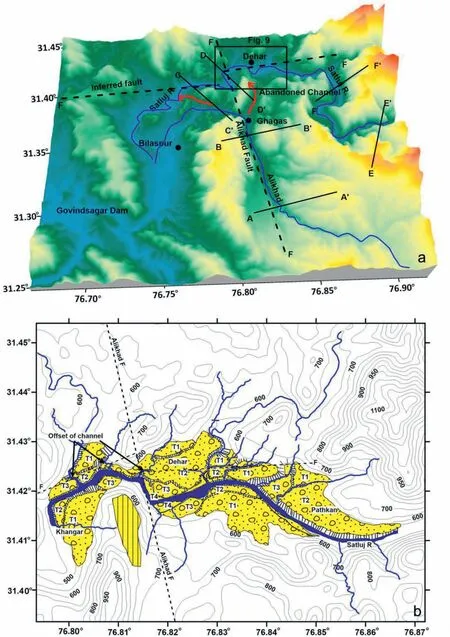
Fig. 2. (a) Digital Elevation Model showing the topographic configuration of the study area. Satluj and its tributary (Alikhad) are marked by blue lines, and the abandoned paleochannels are highlighted by red arrowhead lines.The black lines A-A′,B-B′,C-C′,D-D′,E-E′, and F-F′ are the directions of cross profiles constructed for estimating valley floor width and height ratio.(b)Geomorphic map of Dehar and its surroundings showing the development of fluvial stratigraphic terraces.A fault has been marked on the basis of the offset of drainage pattern and highlighted by the black dotted line in E-W direction.
In this work, tectonic influence on the landscape has been determined using drainage anomalies. The drainage network was obtained from a digital elevation model(DEM).The DEM generated with Surfer 11 software was created using 1:25,000 topographic maps with 10 m contour intervals(Fig.2).The 3-arcsecond Shuttle Radar Topographic Mission (SRTM) data with 90 m was used for creating shaded relief images of the terrain. The seismotectonic characteristics and stress regime of Bilaspur were analyzed using Gutenberg-Richter frequency magnitude distribution and b-value[77]. The stress pattern was further verified using the maximum likelihood method [78,79] and the Z-map software. Geomorphic indices have proved to be a valuable tool in tectonically active areas[17,80]. The indices used in this study were the transverse topographic symmetry factor (T), asymmetry factor (AF), valley width/height ratio (V), and stream length-gradient (SL) index. A combination of the first two helped to infer the tectonic instability of the basin,while the latter two inferred the tectonic environment on the basis of drainage. Stream Power Incision Model(SPIM)was used to predict the pattern of deformation and landscape evolution by deriving the normalized Steepness Index. We adopted Chi analysis to evaluate the disequilibrium state of the drainage basin[81]. These indices are provided in Table 1.

Fig. 3. (a) Longitudinal profile of Satluj river basin. (b) Longitudinal profile of elevation-distance and drainage area-distance. (c) Longitudinal profile of Satluj combined with the normalized steepness values (ø = 0.45). (d) The slope and area plot of the Satluj basin. The lithologies are shown below the long profile.

Table 1 Morphometric parameters and stream power incision model used in the study.
The temporal variability of the deformation pattern in the lower catchment of the Satluj basin was estimated using the Persistent Scatterer Interferometric Synthetic Aperture Radar(PSInSAR) technique [93]. We analyzed the ground deformation during the period of 2015-2020 using the SENTINEL-1A data and C-band Interferometric Wide (IW) swath with dual-polarization VV + VH, which were acquired in descending direction. About 125 images from September 16, 2015 to December 18, 2020 were used to establish the time series deformations with a 12-day repeat cycle (Fig. 4a). The Persistent Scatterers Interferometry(PSI) technique was carried out using the SARPROZ software,which was developed by Perrisin [94]. In Sarproz, the multitemporal SAR data was adopted where spatial connections in interferogram phases were used to find mild-phase changes in terrain[95,96].The differential phase difference(Δφ)between the two SAR images is the sum of the topographic phase (fringes caused due to topography, namely φ), the orbital phase (φappears due to changes in the baseline of two SAR acquisitions),the deformation phase (φproduced due to the seismic, tectonic, climatic or anthropogenic activity), the atmospheric phase(φcaused due to the tropospheric delay of the signal),and the phase noise (φdepending on temporal and geometrical decorrelation of the targets).The differential phase difference can be expressed as:

The PSI method requires the acquisition of as many scenes as possible to process and obtain accurate deformation rates for altitude variations with an external DEM [97]. After importing all the SAR images in SARPROZ software,the master scene is automatically selected after considering the absence of significant weather(such as precipitation or atmospheric turbulence)during the acquisition time and date.
The baseline estimation and coherence for the SENTINEL-1A data set were generated to select the best pair for interferometry.Only those pairs with coherence values greater than 0.68 and the optimum baselines were retained for phase information analysis(Fig. 4b).
4. Result and interpretation
The normalized steepness index(k)for the entire Satluj basin was calculated to identify the areas of varying steepness. The analysis shows the presence of higher variation of kfor a wide zone located between MCT and MBT, where abnormal changes in gradient have been observed south of Dehar (Fig. 3a and b). Here the river flows through the Dharamshala rock group.In the south of Dehar, the values of gradient and steepness decrease, which indicates the higher erodibility of Siwalik rocks. We used a longitudinal profile to delineate the knickpoints. The log-log plot of drainage to slope area (Fig. 3c and d) is combined with the longitudinal length of the channel. It is obvious that the drainage area increases within the lithological and tectonic boundaries. The topographic slope is gradual if the river crosses through the structural discontinuities, and those breaks appear as knick points in the slope-area plots. The inverse relationship of slope and drainage is clearly visible between Jeori and Majhas within JT and MCT zones.However,changes in drainage area and slope between MBT and HFT are directly correlated with tectonic activity.
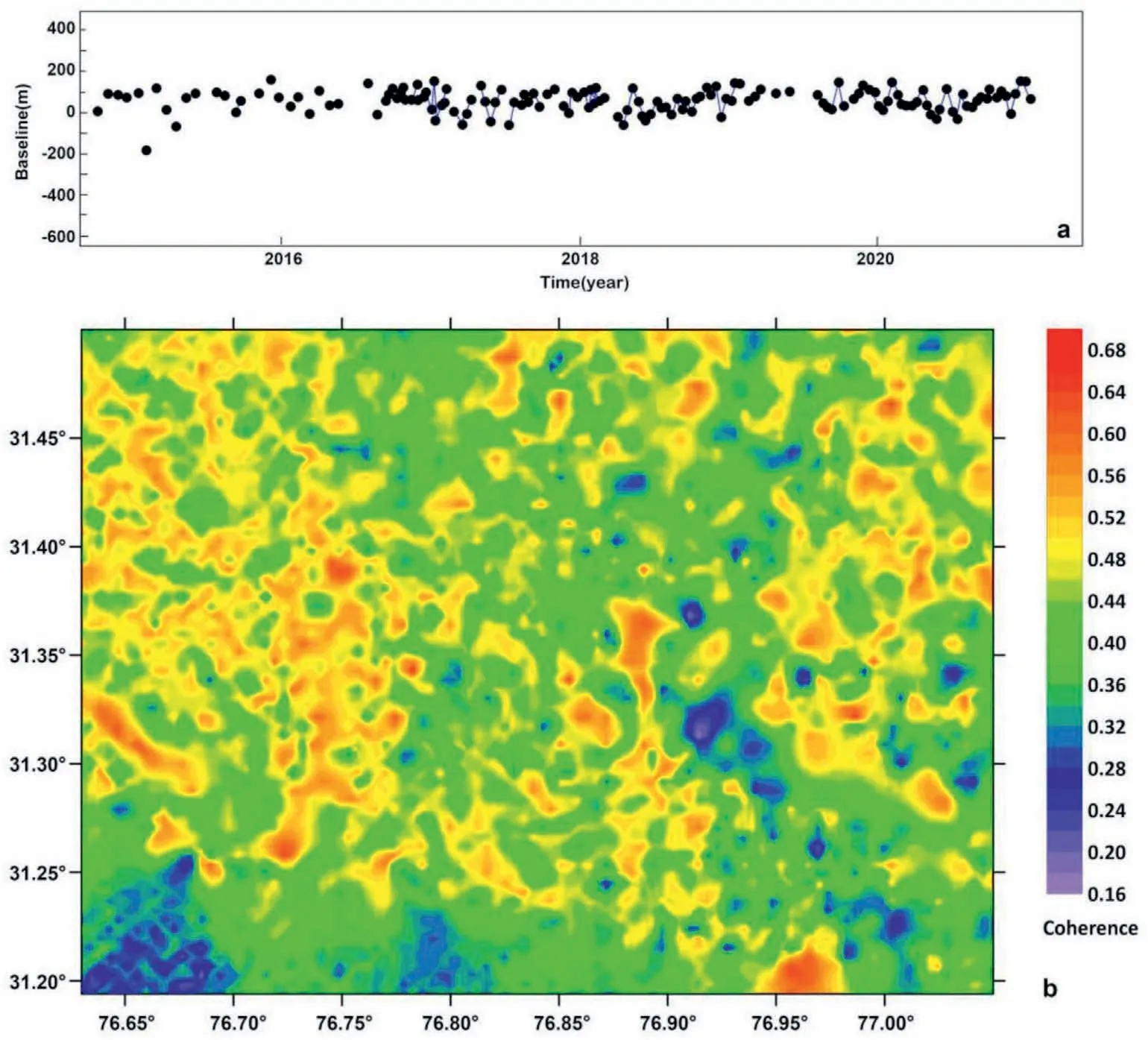
Fig.4. (a)Baseline time series of Sentinel-1A band Interferometric Wide swath(IW)with dual-polarization VV+VH for the period of 2015-2020.(b)Phase filtered coherence map of the study area.
Chi-square plots of river Satluj and its tributaries were generated to analyze the best fit m/n ratio(0.1-0.9).Statistically,the best fit of m/n ratio was selected based on the drop of branch channel at a trijunction of the main rivers in the drainage basin [41]. The best fit value of m/n ratio for Satluj is 0.71[98].The Chi(χ)plot of Satluj and its tributaries clearly shows the presence of convex and concave profiles with reference to the steady state trend line, where the convex profile is compared with the zone of uplift and the concave profile is correlated with the zone of erosion(Fig.5a and b)[98].The divergence of profiles indicates that the river basins are in an unbalanced state due to the influence of lithology and tectonics.Based on the nature of the Chi-square plot and the underlain lithology,the stream profile of Satluj and its tributaries were divided into three zones, namely the MCT zone (orographic barrier), the uplift zone(Lesser Himalaya), and the erosion zone (Siwalik Himalaya) (Fig. 5a and b). Towards the north of MCT, the Himalaya with a high relief forms an orographic barrier for higher precipitation and erosion[9,15,45,99]. The orographic barriers are natural landscapes shaped by intense tectonic pulses and regional monsoonal variations[15,100]. Satluj flows across several orographic barriers, mainly the HHC upstream. The river approaches the low resistive lithological boundaries between the MBT and HFT, which is correlated with a zone of higher erosional activity(Fig.5a and b).
In Bilaspur, the tectonic stress along Alikhad and Hidimbadevi faults tilted the drainage basin. AF value of 47.87 indicates that the Satluj river basin is tilted due to the tectonic stresses in the region(Fig. 6). The value of T ranges between 0 and 1. T = 0 suggests a perfectly symmetrical basin and T = 1 indicates a perfectly asymmetrical one [98]. As shown in Fig. 6, T values were calculated in different parts of the drainage basin.The value of T approaches 1 in the vicinity of the two faults.The SL values are expressed graphically with SL on the y-axis and L on the x-axis, superimposed onto the longitudinal profile of the main watercourse (Fig. 7). This index correlated with the stream power is sensitive to variations in channel slope. The increase in values indicates changes in rock resistance,tectonic disturbances,and stream power[98,99].The integrated plot of stream longitudinal profile and SL index indicates the effect of lithology and tectonic disturbances on stream development. SL values of Satluj and its tributaries show a steep rise in the vicinity of the faults(Fig.7).The rejuvenated stream starts to erode its channel vertically downward to reach the base level,thereby forming gorges or narrow valleys.By studying the cross-valley profile of this river,we can get a clear picture of a stream's response to tectonically unstable areas.A high width/height ratio of the valley floor(seen in a broad valley) is the characteristic of a tectonically stable setting where the river erodes laterally.In contrast,a low width/height ratio of the valley floor(seen in a steep narrow valley)is linked to recent tectonic movements [100,101]. Vwas calculated along several sections in Satluj valley. Satluj and its tributaries show narrow valley profiles where the streams cross the active faults with corresponding low values of V(Fig.8).
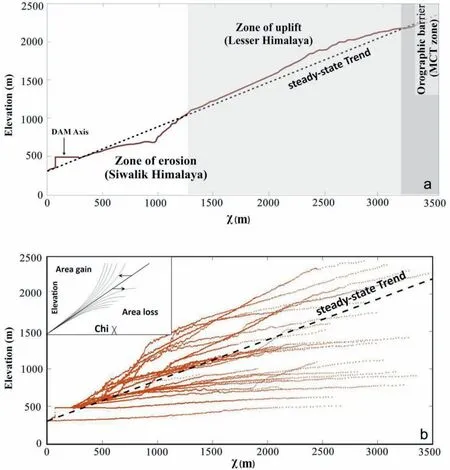
Fig. 5. (a) Variation of the main stream in elevation and Chi plot at m/n = 0.71, where the black dotted line represents the steady state of the river profile and the brown line represents the deviation of the Satluj main stem from the steady state.(b)Elevation and Chi-square plot for all the tributaries of the Satluj basin.The inset in the upper left corner shows the chi effect model of the drainage pattern.
5. Drainage behaviour
The Satlui River is a dendritic system, and the morphology changes as it flows through the fault zone.The higher-order streams show a structural trend, while the lower-order streams show significant offsets as they pass through the fault zone. Strike-slip movement along faults leads to the offset of surface features,creating streams, ridges, and other landforms. Rivers respond to active strike-slip faulting by carving features such as linear valleys and offset channels (Fig. 9). Offsetting of channels produces beheaded streams.In Bilaspur,the Satluj river has been deflected at rightanglesalongtheAlikhad fault(Figs.2and9).There isanoffsetof the tributary along the inferred active fault zone as well.Satluj forms angular compressed meanders deflecting northward. In this area,the river flows in a deep gorge. Abandoned channel deposits were observed at Beri and Kandror (Fig. 9). The present channel flows 100 m northwestof these palaeodeposits.In Bilaspur,both Satluj and its tributary were deflected at right angles along the NNW-SSE Ali khad fault[102].The Ali khad stream follows a fault-controlled path(along the Ali khad fault),forming a linear valley for a considerable distance before getting deflected.In this valley,landslide cones and springs are also aligned in a linear fashion(Fig.10).
The longitudinal river profile is a powerful tool for detecting even the slightest turmoil along its route[101].Theoretically,it is a gentle concave curve, but any kind of subsurface disturbance or tectonic rejuvenation creates abrupt bumps in the profile.In this way,we can accurately locate the subsurface activity.The longitudinal profile of Satluj shows convexities at three places, which are consistent with inferred fault-related subsurface activity(Fig.3a,b,and c).
In tectonically unstable areas, the formation of unpaired strath terraces originates from the internal mechanics of bedrock rivers meandering in vertically incising channels.Deflected Ali Khad stream at Kudi has exposed three levels of unpaired terraces on the left and right bank of the stream(Fig.2a and b).T1 is the oldest,and T3 is the youngest.The terraceT1isgreaterthan150m inheight(Fig.2aandb).
6. b-value interpretation

Fig. 6. Digital elevation model showing estimated values of the basin asymmetry and topographic symmetric factor.
In order to verify the tectonic data generated by drainage anomalies, we used the seismic data characterized by b-value(Fig. 11). The b-value is a parameter used to measure the relative concentration of earthquakes occurring in an area during a certain time period [103]. The Gutenberg-Richter magnitude-frequency relationship for earthquakes is given by logN = a - bM, where M is the magnitude,N is the number of earthquakes of magnitude ≥M,a is a constant,and b determines the relative number of earthquakes of different magnitudes[77].In tectonic areas,the b-value is generally around 1.0 [104]. This value may increase to more than 1 in seismically active areas and 3 in volcanic areas[105,106].The b-value is a useful tool in calculating the state of stress on active faults[107-109].According to seismologists,stress is the most significant parameter affecting the b-value among all factors. It has been established that an increase in accumulating stresses or effective stress[110]can decrease b-values.Differential stress and the b-value have an inverse relationship,which is why the b-value is also called‘stress meter’ in the Earth's crust. Areas recording low b-values are known to rupture into high magnitude earthquakes[111].
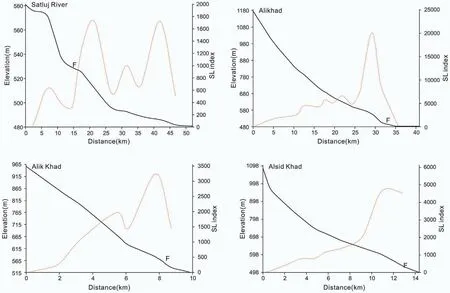
Fig. 7. Longitudinal profiles of Satluj and its tributaries. The values of SL index are marked by red dotted lines.

Fig. 8. Cross valley profiles of Satluj and its tributaries showing the width/height ratio (Vf) values of the valley floor. The location and profile direction are shown in Fig. 2.

Fig. 9. Anomalous drainage behaviour (beheaded streams, offset, and abandoned channels) near the fault zone.

Fig.10. Drainage map of the study area showing prominent river offsets within the fault zone. The major offset zones are highlighted by insets a-c.
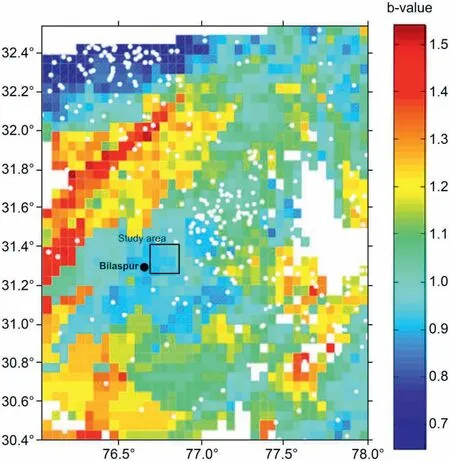
Fig.11. Gutenberg-Richter frequency distribution(b-value)map of Himachal Pradesh.The b-value of Bilaspur is less than 1,indicating that it is an area with accumulated stresses and intense underground activities.
7. Insar results
We analyzed the active surface deformation for a wide zone located between latitude 31.13-31.50and longitude 76.63-77.05. Structurally, the area is crossed by Barsar Back Thrust (BBT), Barasar Thrust (BrT), Main Boundary Thrust (MBT),and Main Central Thrust (MCT) (Fig. 12a and b). The active deformation of these thrusts was estimated using PS-InSAR. We used SENTINEL-1A (125 images) data sets acquired during the period of 2015-2020. The PSI results reveal that the region was deforming with a velocity of±5 to±11 mm/yr during 2015-2020(Fig. 12a). These rates are consistent with previous geodetic observations (11.2 ± 3.8 mm/yr to 14 ± 2 mm/yr) in the northwest Himalayas[51,54,111].Furthermore,we estimated the cumulative displacement of the area, and the values range from +25 to -50 mm/yr (Fig. 12b). Our analysis suggests that an area of approximately 340 kmlocated between the MBT and BBT zone shows a significant amount of subsidence with an average velocity of 10 mm/yr and a cumulative displacement of-30 to-50 mm/yr(Fig. 12a and b). It is to be noted that the Bilaspur lies between Barasar thrust and MBT. The intense subsurface activity, subsidence,and displacement have a profound effect on the drainage of the area. Unnoticed subsurface activity is not only recorded but also magnified by the drainage of the area. Additionally, a cumulative displacement of ±18 mm/yr is shown in a total area of about 1000 km(Fig.12b).

Fig.12. (a)PS-InSAR velocity estimated from the SENTINEL-1A data for the period of 2015-2020.(b)Cumulative displacement map of the study area.The velocity profile direction is provided by P1-P6, and P7-P12 are the profile directions of cumulative displacement.
Six velocity profiles (P1-P6) and six cumulative displacement profiles (P7-P12) were prepared to show vertical strike variations of deformation and displacement.These profile lines are shown in Fig.12 and graphically represented in Fig.13.P1,P2,and P3 clearly show a surface uplift between BT and BBT and a significant amount of subsidence to the north of BT. P4, P5, and P6 show a negligible amount of subsidence in the area. According to P7, P8 and P9 profiles, the cumulative displacement range of MBT and BT zones along BBT is ± 10 mm / yr and ± 14 mm / yr to -45 mm / yr,respectively. P10,P11, and P12 show major displacements of ±6 to±18 mm south of MCT and±14 mm north of the MCT zone(Fig.13).
8. Discussion and conclusion
An integrated methodology using DEM analysis and drainage anomaly monitoring is beneficial to identify subtle tectonic movements in a seismically inactive area of southwest Himachal Pradesh. River displacement of more than 100 m, 15-20 m thick abandoned channel deposits,150 m high unpaired strath terraces,and river entrenchment indicate the active nature of the faults traversing the area [102]. Appreciable movements along these faults have been discerned through drainage anomalies. The drainage basin has tilted due to the active nature of the faults.GPS studies revealed that the southwestern part of Himachal Pradesh falls in the zone of increasing stress and is likely to rupture during major seismic events [51]. Another study established that the region lies in a seismically locked part of the Himalayas,located in a stress accumulation zone [74]. It can be clearly seen that in most other states, the accumulated seismic energy is released intermittently, while Bilaspur has remained seismically inert. A linear belt of the seismically quiescent zone is formed by Bilaspur and its neighbouring districts of Solan and Una. This linear zone happens to be located near the foothill thrust, which is known to be accumulating stresses.

Fig.13. Velocity profiles(P1-P6)marked in red and cumulative displacement profiles(P7-P12)marked in green are constructed from the elevation profiles marked in black colour.
Detection and analysis of drainage anomalies can be an additional tool to study the tectonic behaviour of an area. Such smallscale tectonic disturbances are magnified by the streams flowing on the surface.Even the slightest of disturbances are recorded.The movement along the faults, their nature, and the extent can be accurately discerned. Subsurface tectonic disturbances are always associated with the release of accumulating stresses.Whether this manifests as a disastrous earthquake depends on the magnitude of the stresses released. The small-scale disturbances cannot be ignored as these are the precursors of stress buildup and giant seismic events.If used with other tools,drainage anomalies can be a significant aid in the study of active tectonics.
Bilaspur in northwestern Himalaya lies in the zone of accumulating stresses.The PSI results of SENTINAL-1A data sets reveal that the region has deformed with a velocity of±5 to±11 mm/yr during 2015-2020.Bilaspur lies between Barsar thrust and MBT. Velocity profiles P1,P2,and P3 clearly show a surface uplift between BT and BBT and a significant amount of subsidence to the north of BT.The intense subsurface activity, subsidence, and displacement have a profound effect on the drainage.The analysis of kand χ anomalies suggests that tectonic processes significantly affect the Satluj river profile in northwestern Himalayan region, indicating the disequilibrium state of the river,while morphometric parameters such as asymmetry factor (AF), valley floor width/height ratio (V), and SL index present the turmoil of Satluj and its tributaries in the form of drainage anomalies.
Conflicts of interest
The authors declare that there is no conflicts of interest.
Acknowledgments
MJ acknowledges the Department of Science and Technology(DST) for financial assistance under the DST Women Scientist Scheme(reference no.SR/WOS-A/EA-20/2019(G))and Department of Geology, Kumaun University, Nainital for providing work facilities. GCK is grateful to the Ministry of Earth Science for partial assistance under the AMF mapping program.
杂志排行
Geodesy and Geodynamics的其它文章
- Quaternary tectonic history of seismically active intraplate Kachchh Rift Basin, western India: A review
- Relative active tectonics evaluation using geomorphic and drainage indices, in Dadra and Nagar Haveli, western India
- Manifestation of earthquake preparation zone in the ionosphere before 2021 Sonitpur, Assam earthquake revealed by GPS-TEC data
- Integrated water vapor during active and break spells of monsoon and its relationship with temperature, precipitation and precipitation efficiency over a tropical site
- Geodetic characterization of active Katrol Hill Fault (KHF) of Central Mainland Kachchh, western India
- Crustal deformation measurements by global positioning system(GPS) along NSL, western India
